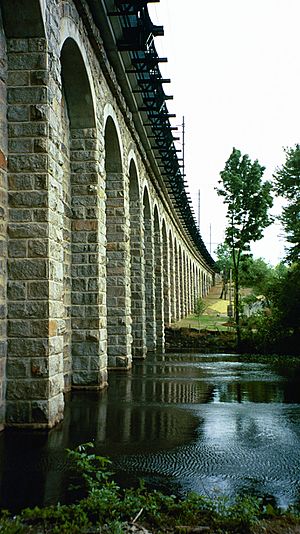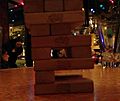Cantilever facts for kids

A cantilever is a strong part of a building or structure, like a long beam or a flat plate. It's special because it's only held firmly at one end. The other end sticks out freely, like a diving board over a swimming pool. Cantilevers can also be made from criss-crossing metal frames called trusses, or from flat concrete slabs.
When something pushes down on the free end of a cantilever, it carries that weight back to the end that's held firmly. This creates a twisting force and a pulling or pushing stress at the support. Cantilever designs let parts of a building hang out without needing extra supports underneath. This is different from structures held up at both ends, like a simple bridge supported by two pillars.
Contents
Cantilevers in Buildings and Bridges
Cantilevers are used a lot in construction. You can see them in cantilever bridges and in balconies that stick out from buildings. In cantilever bridges, two cantilevers often reach out from opposite sides, meeting in the middle or supporting a central section. The famous Forth Rail Bridge in Scotland is a great example of a cantilever truss bridge.
In old timber framed buildings, a part that sticks out is sometimes called a jetty. In the southern United States, there's a type of barn called a cantilever barn, made from logs.
How Cantilevers Help Build Structures
Sometimes, cantilevers are used just while a building or bridge is being put together. Imagine building a bridge over a busy road or a deep river where you can't put temporary supports. Builders can construct parts of the bridge as cantilevers, reaching out from each side until they meet in the middle. This is how many cable-stayed bridges are built. It's one of their main benefits!
Many box girder bridges are also built in small sections. This method works well for "balanced cantilever" construction. Here, the bridge is built outwards in both directions from a single support at the same time.
Famous Cantilever Structures
Many famous buildings use cantilevers. The house called Fallingwater, designed by Frank Lloyd Wright, has large balconies that stick out using cantilevers. The East Stand at Elland Road Stadium in Leeds was once the biggest cantilever stand in the world. It could hold 17,000 fans!
The roof over the stands at Old Trafford Football Ground also uses a cantilever design. This means there are no support poles blocking the view of the field. The old Miami Stadium had a similar roof. Europe's largest cantilevered roof is at St James' Park in Newcastle upon Tyne, home to Newcastle United F.C..
Other examples of cantilevers include tall, free-standing radio towers that don't have support wires. Also, tall chimneys are built like cantilevers. Their strong bases help them resist being blown over by the wind.
Images for kids
-
The pioneering Junkers J 1 all-metal monoplane of 1915, the first aircraft to fly with cantilever wings
-
The Forth Bridge, a cantilever truss bridge
-
Howrah Bridge in India, a cantilever bridge
-
A cantilevered balcony of the Fallingwater house, by Frank Lloyd Wright
-
A cantilever barn in rural Tennessee
-
Cantilever barn at Cades Cove
-
Cantilever facade of Riverplace Tower in Jacksonville, Florida, by Welton Becket and KBJ Architects
-
This radiograph of a "bridge" dental restoration features a cantilevered crown to the left.
See also
 In Spanish: Voladizo para niños
In Spanish: Voladizo para niños















